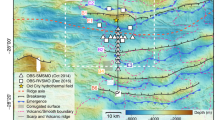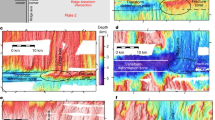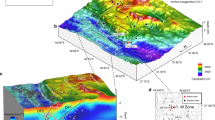Abstract
The formation of oceanic detachment faults is well established from inactive, corrugated fault planes exposed on sea floor formed along ridges spreading at less than 80 km Myr–1 (refs 1–4). These faults can accommodate extension for up to 1–3 Myr (ref. 5), and are associated with one of the two contrasting modes of accretion operating along the northern Mid-Atlantic Ridge. The first mode is asymmetrical accretion involving an active detachment fault6 along one ridge flank. The second mode is the well-known symmetrical accretion, dominated by magmatic processes with subsidiary high-angle faulting and the formation of abyssal hills on both flanks. Here we present an examination of ∼2,500 km of the Mid-Atlantic Ridge between 12.5 and 35° N, which reveals asymmetrical accretion along almost half of the ridge. Hydrothermal activity identified so far in the study region is closely associated with asymmetrical accretion, which also shows high levels of near-continuous hydroacoustically and teleseismically recorded seismicity. Increased seismicity is probably generated along detachment faults that accommodate a sizeable proportion of the total plate separation. In contrast, symmetrical segments have lower levels of seismicity, which occurs primarily at segment ends. Basalts erupted along asymmetrical segments have compositions that are consistent with crystallization at higher pressures than basalts from symmetrical segments, and with lower extents of partial melting of the mantle. Both seismic evidence and geochemical evidence indicate that the axial lithosphere is thicker and colder at asymmetrical sections of the ridge, either because associated hydrothermal circulation efficiently penetrates to greater depths or because the rising mantle is cooler. We suggest that much of the variability in sea-floor morphology, seismicity and basalt chemistry found along slow-spreading ridges can be thus attributed to the frequent involvement of detachment faults in oceanic lithospheric accretion.
This is a preview of subscription content, access via your institution
Access options
Subscribe to this journal
Receive 51 print issues and online access
$199.00 per year
only $3.90 per issue
Buy this article
- Purchase on Springer Link
- Instant access to full article PDF
Prices may be subject to local taxes which are calculated during checkout




Similar content being viewed by others
References
Tucholke, B. E. et al. Role of melt supply in oceanic detachment faulting and formation of megamullions. Geology 36, 455–458 (2008)
Cann, J. R. et al. Corrugated slip surfaces formed at North Atlantic ridge-transform intersections. Nature 385, 329–332 (1997)
Cannat, M. et al. Modes of seafloor generation at a melt-poor ultraslow-spreading ridge. Geology 34, 605–608 (2006)
Okino, K. et al. Development of oceanic detachment and asymmetric spreading at the Australian-Antarctic Discordance. Geochem. Geophys. Geosyst. 5 10.1029/2004GC000793 (2004)
Tucholke, B. E., Lin, J. & Kleinrock, M. C. Megamullions and mullion structure defining oceanic metamorphic core complexes on the Mid-Atlantic Ridge. J. Geophys. Res. 103 (B5). 9857–9866 (1998)
Smith, D. K., Cann, J. R. & Escartín, J. Widespread active detachment faulting and core complex formation near 13° N on the Mid-Atlantic Ridge. Nature 443, 440–444 (2006)
Smith, D. K. et al. Fault rotation and core complex formation: Significant processes in seafloor formation at slow spreading mid-ocean ridges (Mid-Atlantic Ridge, 13–15° N). Geochem. Geophys. Geosyst. 9 10.1029/2007GC001699 (2008)
Buck, W. R., Lavier, L. L. & Poliakov, A. N. B. Modes of faulting at mid-ocean ridges. Nature 434, 719–723 (2005)
Fujiwara, T. et al. Crustal evolution of the Mid-Atlantic Ridge near the Fifteen-Twenty Fracture Zone in the last 5 Ma. Geochem. Geophys. Geosyst. 4 10.1029/2002GC000364 (2003)
Canales, J. P. et al. Seismic structure across the rift valley of the Mid-Atlantic ridge at 23° 20' N (MARK area): Implications for crustal accretion processes at slow-spreading ridges. J. Geophys. Res. 105 (B12). 28411–28425 (2000)
Smith, D. K. et al. Hydroacoustic monitoring of seismicity at the slow-spreading Mid-Atlantic Ridge. Geophys. Res. Lett. 29 10.1029/2001GL013912 (2002)
Bohnenstiehl, D. et al. Aftershock sequences in the mid-ocean ridge environment: an analysis using hydroacoustic data. Tectonophysics 354, 49–70 (2002)
deMartin, B. J. et al. Kinematics and geometry of active detachment faulting beneath the Trans-Atlantic Geotraverse (TAG) hydrothermal field on the Mid-Atlantic Ridge. Geology 35, 711–714 (2007)
Smith, D. K. et al. Spatial and temporal distribution of seismicity along the northern Mid-Atlantic Ridge (15°–35° N). J. Geophys. Res. 108 (B3). 10.1029/2002JB001964 (2003)
Kong, L. S., Solomon, S. C. & Purdy, G. M. Microearthquake characteristics of a mid-ocean ridge along-axis high. J. Geophys. Res. 97, 1659–1685 (1992)
Toomey, D. R. et al. Microearthquakes beneath the median valley of the Mid-Atlantic ridge near 23° N: hypocenters and focal mechanisms. J. Geophys. Res. 90, 5443–5458 (1985)
Barclay, A. H., Toomey, D. R. & Solomon, S. C. Microearthquake characteristics and crustal Vp/Vs structure at the Mid-Atlantic Ridge, 35° N. J. Geophys. Res. 106 (B2). 2017–2034 (2001)
Wolfe, C. et al. Microearthquake characteristics and crustal velocity structure at 29° N of the Mid-Atlantic Ridge: The architecture of a slow-spreading segment. J. Geophys. Res. 100 (B12). 24449–24472 (1995)
Klinkhammer, G. et al. Hydrothermal manganese plumes in the Mid-Atlantic Ridge rift valley. Nature 314, 727–731 (1985)
McCaig, A. et al. Oceanic deachment faults focus very large volumes of black smoker fluids. Geology 35, 935–938 (2007)
Boschi, C. et al. Mass transfer and fluid flow during detachment faulting and development of an oceanic core complex, Atlantic Massif (MAR 30° N). Geochem. Geophys. Geosyst. 7 10.1029/2005GC001074 (2006)
Bougault, H. et al. Mantle heterogeneity from trace elements: MAR triple junction near 14° N. Earth Planet. Sci. Lett. 88, 27–36 (1988)
Klein, E. & Langmuir, C. H. Local versus global variations in ocean ridge basalt composition: a reply. J. Geophys. Res. 94 (B4). 4241–4252 (1989)
Lissenberg, C. J. & Dick, H. J. B. Melt–rock reaction in the lower oceanic crust and its implications for the genesis of mid-ocean ridge basalt. Earth Planet. Sci. Lett. 271, 311–325 (2008)
Escartín, J. et al. Quantifying tectonic strain and magmatic accretion at a slow spreading ridge segment, Mid-Atlantic Ridge, 29° N. J. Geophys. Res. 104 (B5). 10421–10437 (1999)
Macdonald, K. C. & Luyendyk, B. P. Deep-Tow studies of the structure of the Mid-Atlantic Ridge crest near lat 37° N. Geol. Soc. Am. Bull. 88, 621–636 (1977)
McAllister, E. & Cann, J. R. in Tectonic, Magmatic, Hydrothermal and Biological Segmentation of Mid-Ocean Ridges Vol. 118 (eds MacLeod, C. J., Tyler, P. A. & Walker, C. L.). 29–48 (1996)
Carbotte, S. M. et al. New integrated data management system for Ridge2000 and MARGINS research. EOS Trans. Am. Geophys. Un. 85, 553–559 (2004)
Müller, R. D. et al. Digital isochrons of the world's ocean floor. J. Geophys. Res. 102 (B2). 3211–3214 (1997)
Lehnert, K. et al. A global geochemical database structure for rocks. Geochem. Geophys. Geosyst. 1, 1999GC000026 (2000)
Su, Y. J. Mid-Ocean Ridge Basalt Trace Element Systematics: Constraints from Database Management, ICPMS Analyses, Data Compilation and Petrological Modeling (Univ. Columbia, 2002)
Davydov, M. P. et al. Ferromanganese deposits in the Ashadze-1 hydrothermal field (Mid-Atlantic Ridge, 12° 58′ N). Dokl. Earth Sci. 415A, 954–960 (2007)
Beltenev, V. et al. New hydrothermal sites at 13° N, Mid Atlantic Ridge. InterRidge News 14, 14–16 (2005)
Beltenev, V. et al. A new hydrothermal field at 13° 30′ N on the Mid-Atlantic Ridge. InterRidge News 16, 10–11 (2007)
Batuyev, B. N. et al. Massive sulphide deposits discovered and sampled at 14° 45′ N, Mid-Atlantic Ridge. Bridge Newslett. 6, 6–10 (1994)
Beltenev, V. et al. A new hydrothermal field at 16° 38.4′ N, 46° 28.5′ W on the Mid-Atlantic Ridge. InterRidge News 13, 5–6 (2004)
Ocean Drilling Program Leg 106 Scientific Party Drilling the Snake Pit hydrothermal sulfite deposit on the Mid-Atlantic ridge, lat 23° 22′ N. Geology 14, 1004–1007 (1986)
Rona, P. A. et al. Black smokers, massive sulphides and vent biota at the Mid-Atlantic Ridge. Nature 321, 33–37 (1986)
James, R. H., Elderfield, H. & Palmer, M. R. The chemistry of hydrothermal fluids from the Broken Spur site, 29° N Mid-Atlantic Ridge. Geochim. Cosmochim. Acta 59, 651–659 (1995)
Kelley, D. S. et al. An off-axis hydrothermal vent field near the Mid-Atlantic Ridge at 30° N. Nature 411, 145–149 (2001)
Cann, J. & Smith, D. K. Evolution of volcanism and faulting in a segment of the Mid-Atlantic Ridge at 25° N. Geochem. Geophys. Geosyst. 6, Q09008 (2005)
Langmuir, C. H. et al. in Back-arc Spreading Systems: Geological, Biological, Chemical and Physical Interactions (eds Christie, D. M. et al.) 87 (AGU Geophys. Monogr. Series, 2006)
Acknowledgements
This work was carried out during a during a 16-month visit to Harvard University and MIT by J.E., and was supported by CNRS (J.E.), NSF (D.K.S., H.S., C.L. and S.E.), WHOI (J.E., D.K.S., H.S. and J.C.), Harvard University (J.E., C.L. and S.E.), University of Leeds (J.C.) and MIT (J.E.). We thank M. Cannat and J. P. Canales for discussions, and W. R. Buck and B. Ildefonse for reviews. This is IPGP contribution 2404.
Author information
Authors and Affiliations
Corresponding author
Additional information
Author Contributions All authors contributed to the interpretation and analysis of the data. J.E. led the data analysis and writing of the manuscript, with contributions from all the co-authors.
Supplementary information
Supplementary Information
This file contains Supplementary Figures 1a -q, 2 and 3 with Legends and Supplementary Table 1 (PDF 10534 kb)
Rights and permissions
About this article
Cite this article
Escartín, J., Smith, D., Cann, J. et al. Central role of detachment faults in accretion of slow-spreading oceanic lithosphere. Nature 455, 790–794 (2008). https://doi.org/10.1038/nature07333
Received:
Accepted:
Issue Date:
DOI: https://doi.org/10.1038/nature07333
This article is cited by
-
Geophysical investigation of the Mado Megamullion oceanic core complex: implications for the end of back-arc spreading
Progress in Earth and Planetary Science (2023)
-
How transform fault shear influences where detachment faults form near mid-ocean ridges
Scientific Reports (2023)
-
Volcanic evolution of an ultraslow-spreading ridge
Nature Communications (2023)
-
Microseismicity and lithosphere thickness at a nearly-amagmatic oceanic detachment fault system
Nature Communications (2023)
-
Generation of ultraslow-spreading oceanic crust traced by various mafic blocks from ophiolitic mélange in the Xigaze Ophiolites, southern Tibet
Contributions to Mineralogy and Petrology (2023)
Comments
By submitting a comment you agree to abide by our Terms and Community Guidelines. If you find something abusive or that does not comply with our terms or guidelines please flag it as inappropriate.



